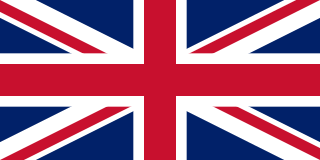The Cree are one of the largest groups of First Nations in North America.
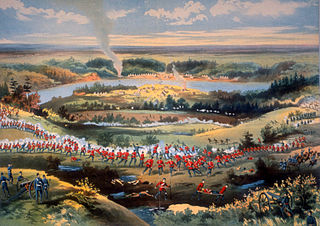
The North-West Rebellion of 1885 was a brief and unsuccessful uprising by the Métis people under Louis Riel and an associated uprising by First Nations Cree and Assiniboine of the District of Saskatchewan against the government of Canada. Many Métis felt Canada was not protecting their rights, their land and their survival as a distinct people. Riel had been invited to lead the movement of protest. He turned it into a military action with a heavily religious tone. This alienated Catholic clergy, whites, most Indigenous tribes and some Métis. But he had the allegiance of a couple hundred armed Métis, a smaller number of other Indigenous warriors and at least one white man at Batoche in May 1885, confronting 900 Canadian militia plus some armed local residents. About 91 people would die in the fighting that occurred that spring, before the rebellion's collapse.

The Battle of Cut Knife, fought on May 2, 1885, occurred when a flying column of mounted police, militia, and Canadian army regular army units attacked a Cree and Assiniboine teepee settlement near Battleford, Saskatchewan. First Nations fighters forced the Canadian forces to retreat, with losses on both sides.
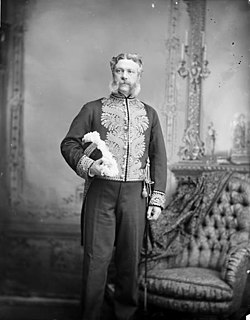
Edgar Dewdney, was a Canadian surveyor, road builder, Indian commissioner and politician born in Devonshire, England. He emigrated to British Columbia in 1859 in order to act as surveyor for the Dewdney Trail that runs through the province. In 1870, Dewdney decided to take up a role in Canadian government. In this year, he was elected to the Legislative Council of British Columbia as a representative form the Kootenay region. In 1872, he was elected as a member of Federal Government for the Yale region representing the Conservative party. He was reelected to this position in 1874 and again in 1878. Dewdney served as Lieutenant Governor of the North-West Territories from 1879 to 1888, and the fifth Lieutenant-Governor of British Columbia from 1892 to 1897. Additionally, he served as the Indian commissioner in the North-West Territories from 1879 until 1888. In 1897, Dewdney retired from politics and began working as a financial agent until his death in 1916.
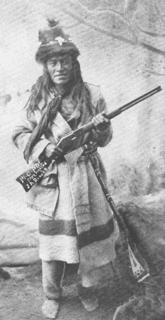
Piapot, Payipwât, or Payipwat, born as Kisikawasan, known by his Assiniboine allies as Maȟpíya owáde hókši was a Native Canadian chief of the Cree-Assiniboine / Young Dogs Band, a mighty band and division of the Downstream People (Māmihkiyiniwak) of the Plains Cree. He was one of the five major leaders of the Plains Cree after 1860.
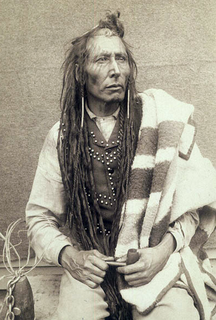
Pîhtokahanapiwiyin, better known as Chief Poundmaker, was a Plains Cree chief known as a peacemaker and defender of his people.
First Nations in Saskatchewan constitute many Native Canadian band governments. First Nations ethnicities in the province include the Cree, Assiniboine, Saulteaux, Dene and Dakota. Historically, the Atsina and Blackfoot could also be found at various times.
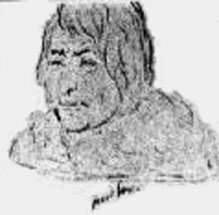
Crazy Bear (1785–1856) was an Indian chief of the Assiniboine tribes of the northern plains. Their territory included Montana, North Dakota, Alberta and Saskatchewan. He is known as a skilled negotiator with the American Fur Company at Fort Union, North Dakota; and for his participation and representation at the Fort Laramie Treaty Council of 1851—where he was a signatory of the treaty' He earned the name Mah-To-Wit-Ko because he fought like a crazy bear. "Wit-Ko" is a Siouan word that has multiple translations: crazy, foolish, frightening and mad. Crazy Bear has been recorded by these names and also in French as Ours Fou.

The Frog Lake Massacre was part of the Cree uprising during the North-West Rebellion in western Canada. Led by Wandering Spirit, young Cree men attacked officials, clergy and settlers in the small settlement of Frog Lake in the District of Saskatchewan in the Northwest Territories on 2 April 1885. Nine settlers were killed in the incident.

Treaty 4 is a treaty established between Queen Victoria and the Cree and Saulteaux First Nation band governments. The area covered by Treaty 4 represents most of current day southern Saskatchewan, plus small portions of what are today western Manitoba and southeastern Alberta. This treaty is also called the "Qu'Appelle Treaty," as its first signings were conducted at Fort Qu'Appelle, North-West Territories, on 15 September 1874. Additional signings or adhesions continued until September 1877. This treaty is the only indigenous treaty in Canada that has a corresponding indigenous interpretation.
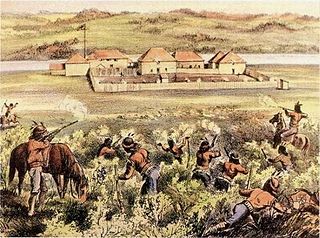
Fort Pitt was a fort built in 1830 by the Hudson's Bay Company that also served as a trading post on the North Saskatchewan River in Canada. It was built at the direction of Chief Factor John Rowand, previously of Fort Edmonton, in order to trade for bison hides, meat and pemmican. Pemmican, dried buffalo meat, was required as provisions for HBC's northern trading posts.
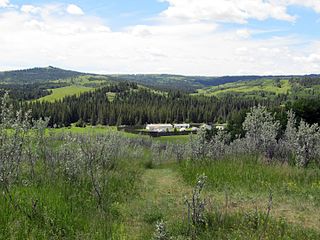
Fort Walsh is a National Historic Site of Canada that was a North-West Mounted Police (NWMP) fort and the site of the Cypress Hills Massacre. Administered by Parks Canada, it forms a constituent part of Cypress Hills Interprovincial Park.
Ermineskin Cree Nation also known as the Ermineskin Tribe, is a band government in Alberta, Canada, a western branch of the large Cree Nation, and a Treaty 6 nation.

The Looting of Battleford began at the end of March, 1885, during the North-West Rebellion, in the town of Battleford, Saskatchewan, then a part of the Northwest Territories.
Saskatchewan Highway 658 connects Saskatchewan Highway 4 near Red Pheasant Indian Reserve 108 to SK Hwy 4 near Battleford. Highway 658 travels around Mosquito Indian Reserve 109, whereas Highway 4 travels north through the Indian Reserve. To the north of Mosquito Indian Reserve 109 is Grizzly Bear's Head and Lean Man Indian Reserve. The centre of Battleford is 1.5 kilometres (0.93 mi) from the Highway 658 Highway 4 junction. The length of Highway 658 is 41.2 kilometres (25.6 mi).
Treaty Four Reserve Grounds Indian Reserve No. 77 is an Indian Reserve in Saskatchewan, Canada, shared by 33 band governments from Saskatchewan and Manitoba. The Reserve Grounds are located adjacent to and west of Fort Qu'Appelle, Saskatchewan. All bands are signatories to Treaty 4. This Reserve may belong to Assiniboine Chief Long Lodge #77. Who was a treaty signatory chief to treaty 4 in 1877 at Cypress Hills
Carry the Kettle Nakoda First Nation #76 is a Nakota (Assiniboine) First Nation located approximately 80 km (50 mi) east of Regina, Saskatchewan, and 13 km (8.1 mi) south of Sintaluta, Saskatchewan. The reservation is in the Treaty 4 territory.
Lawrence Vankoughnet was an agent with Canada's Department of Indian Affairs in the late 19th century. Vankoughnet moved quickly up the ranks of the DIA, beginning as a clerk with family connections to prime minister John A. Macdonald. From chief civil servant to deputy superintendent, Lawrence accomplished a lot when he was present. After a 3-month sick leave for a "disordered nervous system", he wasted little time picking up where he left off. Vankoughnet was noted by many historians to be the man who cut costs on the rations the government supplied to the reserves. Despite only visiting the reserves once, where he was reluctant to socialize with the chiefs, Vankoughnet announced his change of policy plans in Battleford shortly afterwards: Indians would only be supplied with rations if they were unable to sustain themselves. Vankoughnet’s goals as deputy superintendent of the DIA was to keep costs to a minimum. He thought that so long as they were supplying reserve peoples with rations, they would remain dependent on the government and therefore a significant burden to their expenditures.
Mosquito Band Elders: Mary Jane Spyglass, Archie Bugler, William Starchief (2012)


